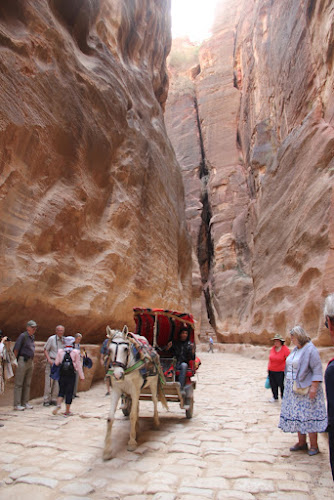We arrive at our new port of Aqaba, in Jordan, for a two day stop and we elect to use each of these to go to Petra, the remarkable sandstone-carved site dating from the 1st century BC.
On the 2 hour drive there, we were told by our Jordanian guides of the history of the Nabataeans, who lived in southern Jordan and from the 4th century BC controlled the important trade routes that passed through their area, carrying silks and spices from the Far East to the Hellenistic world? They became immensely rich and used their wealth to create Petra, which was built in Hellenistic splendour.
It was both a place where about 20,000 lived and a necropolis of tombs, which varied in grandeur according to wealth. The grandest had intricately carved classical, Graeco-Roman facades with rooms inside, whose walls and ceilings have often become naturally decorated by the iron and salts layered in the sandstone, producing richly coloured patterns, of which Jackson Pollock would have been proud.
Petra is in a secluded site entered through a 1200m long, high, narrow gorge, known as the Siq, and containing bizarre-looking, colourful, sandstone formations.
It opens out dramatically at the end to ones first breathtaking view of Al-Khazneh (Pharaoh's Treasury). It was cut from the natural rock, starting at the top and working downwards.
From then on there is much to see in this vast UNESCO World Heritage site of about 240 square kilometres and we felt we had trekked over much of it during two fairly tiring days. Our guides were keen to assure us that there was much more to see and that ideally one should stay in the nearby town so as to see the varying colours of the stone early in the morning, captured in John William Burgon's poem as the 'rose red city half as old as time'.
During our two long journeys back and forth to Petra, we travelled across some country with attractive, deep, rocky Valleys, but much was bleak and arid occupied only by the occasional Bedouin encampment with their sheep and goats. Our guides told us that 5m of the 6.5m population lived in the 3 major cities. They have no oil and there is a lack of water. The king is very much in control. He appoints the Prime Minister who in turn appoints the ministers. There is an elected parliament that in theory can influence decisions. The king decided that education was most important, as Jordan has few natural resources. Our guides were university educated. One of them, Ibrahim, said his grandfather had been a Bedouin and 24 children. His father had 10 children, and each one of them had gone to university. He said of himself that he 'only had 4 children'.
We spent many hours over the two days listening to our Jordanian guides. They each came across as intelligent but above all as men of a deep morality. They spoke of their Islamic religion, which clearly is important to them and their families. There are religious differences with those of us brought up in the Christian culture, which are probably unbridgeable, but it was impossible not to like and respect them.




No comments:
Post a Comment